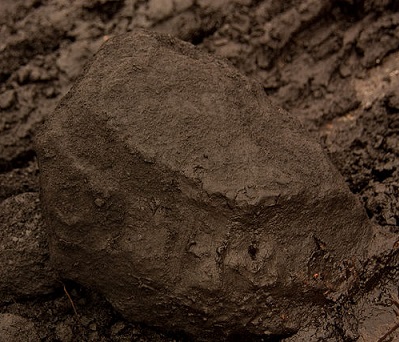Lignite

Coal is a rock made of almost pure carbon. The coal in different deposits have different compositions, therefore, coal is classified in various categories Lignite or brown coal is brown in colour and the lowest quality type of coal. It is a softer coal with a high moisture content and contains the greatest amount of compounds other than carbon—such as sulfur and mercury.[2] The carbon content of lignite ranges from 65-70%[3][4] and represents the youngest rank of fuel—with approximate ages of around 60 million years.
Lignite is the first "stage" of coal that forms after sediment piles on top of layers of peat, which gets heated and compressed. Since lignite has a lower carbon content and has not been buried very long, it does not have as high an energy density as harder black coals. The energy density of lignite is only about (18 MJ/kg),[3] significantly lower than the contents of higher quality coals such as sub-bituminous, bituminous, and anthracite coal.
Uses
Since lignite has a relatively low energy density, the coal is burned close to the mines (known as mine mouth operations). This is done to get the most output from the coal, without expending too much energy transporting it. Lignite's high moisture content and lower carbon content results in more carbon dioxide emissions than harder black coals. In these power plants the coal is burned and used in industrial boilers. 79% of all lignite coal is used in these boilers to generate electricity, and 13.5% is used to generate synthetic natural gas. A small 7.5% is used to produce various fertilizer products. Virtually none is used as a home heating fuel due to its poor burn quality.[5]
For Further Reading
- Coal formation
- Coal
- Fossil fuel
- Mine mouth
- Energy density
- Hydrocarbon combustion
- Coal types
- Or explore a random page
References
- ↑ Wikimedia Commons. (May 13, 2015). Lignite [Online]. Available: http://commons.wikimedia.org/wiki/File:Lignite_Klingenberg.jpg
- ↑ R. Wolfson. Energy, Environment and Climate, 2nd ed. New York, U.S.A.: Norton, 2012, pp. 95-96
- ↑ 3.0 3.1 P. Breeze, Coal-Fired Generation. Elsevier Science, 2015.
- ↑ Stephen Marshak. (May 13, 2015). Earth: Portrait of a Planet, 3rd ed. New York, NY, U.S.A:W.W. Norton & Company, 2008
- ↑ Lignite Energy Council. (May 13, 2015). Lignite Uses [Online]. Available: https://www.lignite.com/about-lignite/lignite-uses/

